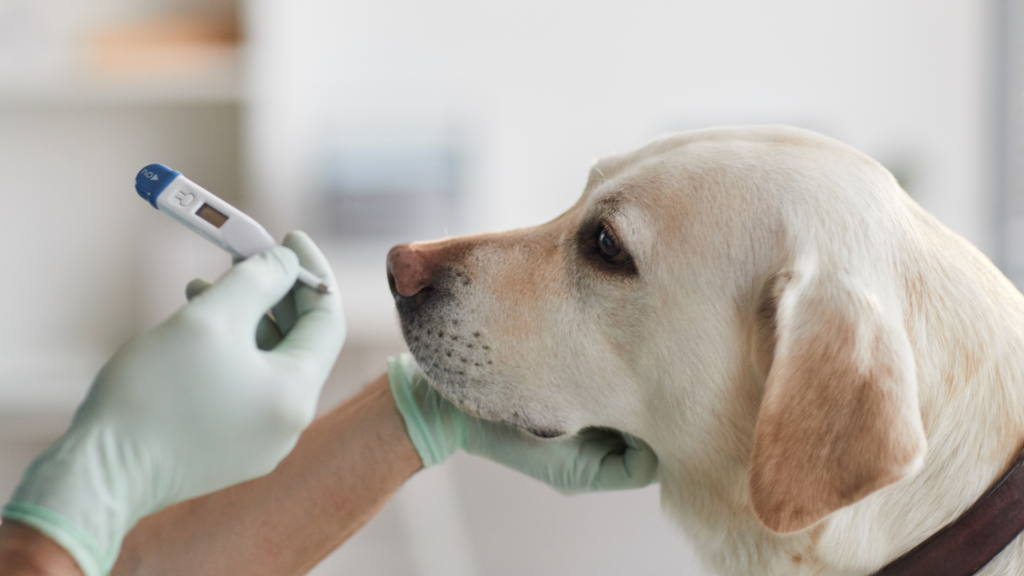Your dog’s temperature is one of the most important indicators of your pet’s health. It can vary slightly depending on breed, age, physical activity, or even the time of day. However, there is a clear line between normal and potentially dangerous.
Being able to recognize when your dog’s body temperature is normal and when it is not can help you spot health problems early and seek veterinary care in a timely manner. An abnormal temperature can signal serious health problems, so it is important to know how to recognize it and what to do.
In this article, we will explain what temperature is considered normal for a dog, how to measure it accurately, and what to do if your dog’s temperature deviates from the norm.
Table of contents
What is a normal body temperature for a dog?
A dog’s normal temperature usually ranges from 37.5 °C to 39.2 °C. This is considered an indicator of good health for most dogs. Minor changes depending on the time of day, physical activity, or stress are natural. However, significant deviations from this range may be a sign that the dog’s body is responding to internal or external stimuli.
To understand whether the temperature has actually deviated from the norm, it is important to know not only the numbers, but also how to measure it correctly.

How to take a dog’s temperature?
Measuring your dog’s temperature at home may seem complicated, but it is an important skill for every owner to learn. Accurately measuring your dog’s body temperature helps you understand whether your pet is healthy or needs help.
The most important thing is to know how to do it safely, using the right equipment and methodology. Even small deviations from the norm can signal an infection, inflammation, or other serious disorder.
Appropriate measures and safe measurement methods
A digital thermometer specially designed for animals is best suited for this purpose, but a thermometer intended for human use can also be used, provided it is used only for your pet. Before use, the thermometer should be coated with petroleum jelly or lubricant to make the procedure as gentle as possible.
Gently lift your dog’s tail and insert the thermometer about 2 cm into the rectum. Hold it until the device records the temperature – this usually takes a few seconds. After taking the measurement, the thermometer must be disinfected.
As mentioned above, a dog’s normal temperature usually ranges from 37.5°C to 39.2°C. Small fluctuations may be normal, but if your dog’s temperature is clearly too high or too low and your pet shows worrying signs such as lethargy, trembling, a dry nose, or loss of appetite, you should consult your veterinarian as soon as possible.

What does an elevated temperature (fever) in a dog mean?
A dog’s fever is the body’s response to infections, inflammation, poisoning, or other health problems. A fever is defined as a body temperature above 39.5°C. This condition usually indicates that the dog’s body is fighting inflammation or infection, but the temperature can also rise due to overheating or even autoimmune reactions.
If your dog becomes unusually lethargic, refuses food or water, pants frequently, or seems depressed, these may be the first signs that your dog has a fever. In this case, it is very important to take their temperature as soon as possible and consult a veterinarian without delay.

The most common causes of fever in dogs
A dog’s body temperature can rise for many different reasons. Sometimes it is a mild inflammation, and sometimes it is a sign of a serious health problem. Below are the most common causes of fever that every owner should be aware of:
- Infections (viral, bacterial, or fungal diseases)
- Inflammatory processes (e.g., arthritis, internal organ disorders)
- Food, chemical, or poisonous plant poisoning
- Overheating due to high air temperatures or direct sunlight
- Emotional stress or fright
- Physical overload, intense running or playing
- Pregnancy and whelping – just before giving birth, a dog’s body temperature may temporarily rise and then drop
If your dog’s temperature exceeds the acceptable limit, it is very important to find out the cause, because fever is not a disease, but a sign that the body is fighting a serious problem.
Reasons for a drop in a dog’s temperature
A low body temperature in dogs – when the body temperature drops below 37°C – is a serious sign that the dog’s body is no longer able to maintain normal heat metabolism. This condition may be associated with hypothermia, shock, chronic diseases, or other serious health problems.
Although there is a lot of talk about high body temperature in dogs, low body temperature is also dangerous and requires immediate attention.

The most common causes of a drop in a dog’s temperature
The reasons why a dog’s body temperature may drop can be as follows:
- Prolonged exposure to cold environments (hypothermia)
- Shock due to trauma, severe bleeding, or serious illness
- Kidney failure or other chronic health conditions
- Poisoning that disrupts the body’s thermoregulation
- Old age and slow metabolism
- End of pregnancy and whelping – before giving birth, a dog’s temperature may drop to 36.5°C, which signals that labor is about to begin
If the temperature drops below 37°C, it is necessary to take action. Too low a temperature can cause organ damage or even be life-threatening. In this case, it is necessary to contact a veterinarian as soon as possible, who will determine the cause and begin appropriate treatment.
Dog overheated in the sun: how to recognize the danger and what to do?
In summer, it is very important to protect your pet from overheating, as this can be life-threatening. Overheating occurs when a dog’s body temperature rises above 40 °C and the body is unable to regulate it in the usual ways. This usually happens on hot days when a dog is exposed to the sun for too long or is left in a car without air circulation.
Symptoms of overheating can include heavy panting, lethargy, and trembling. In more severe cases, the dog may vomit, have diarrhea, lose consciousness, or experience seizures.
If you notice these signs, it is important to take immediate action to cool the dog down and seek veterinary care as soon as possible.

How to prevent your dog from overheating?
To keep your dog’s temperature normal even in hot weather, it is important to take care of their environment, walking times, and ways to cool them down. This is especially important for long-haired, older, and physically active dogs.
Here are some simple but effective ways to help your dog stay cool:
- Walk your dog in the morning or evening. Avoid the hottest hours of the day to prevent overheating.
- Provide shade and access to water. Your dog should always have the opportunity to hide from the sun and drink fresh water.
- Use cooling aids. Cooling mats, damp towels, or a coat lightly moistened with water help regulate body temperature.
- Monitor your dog’s condition. If they are running around more intensely than usual, resting in the shade for long periods of time, or showing signs of lethargy, these may be the first signs of overheating.
Prevention is the simplest way to avoid serious health problems. If you suspect that your dog’s body temperature is too high, you need to act immediately.
How to regulate your dog’s body temperature at home?
A dog’s temperature, whether too high or too low, can be dangerous. Although it is always recommended to seek veterinary care as soon as possible, in some cases, first aid measures at home can help stabilize your pet’s condition and prevent complications.
What to do if the temperature is too high?
If your dog’s body temperature is too high, first move them to a cooler environment. You can wet their coat with cool (but not cold) water, use a fan, or place wet towels on their paws and belly.
Never give your dog medication intended for humans, such as paracetamol or ibuprofen. These are dangerous for dogs and can cause serious complications.
If your dog’s temperature does not drop within 30 minutes, you must contact your veterinarian immediately.

What to do if the temperature is too low?
If the temperature is too low, the dog should be warmed up gradually. Cover it with a warm blanket, offer warm (not hot) water, you can use warm water bottles placed on the chest or stomach. Sudden warming can be dangerous, so it is important to be gentle and monitor your pet’s condition.
If your dog is still shivering, appears weak, or does not respond to warming, contact your veterinarian as soon as possible.

What to do if your dog’s temperature is not normal?
If you notice that your dog’s normal temperature has deviated from the norm and you are unsure whether this is dangerous, it is always better to consult a veterinarian than to wait and risk your pet’s health. Even minor changes can sometimes hide more serious problems.
Make an appointment for a consultation if you have even the slightest suspicion about your dog’s health.





